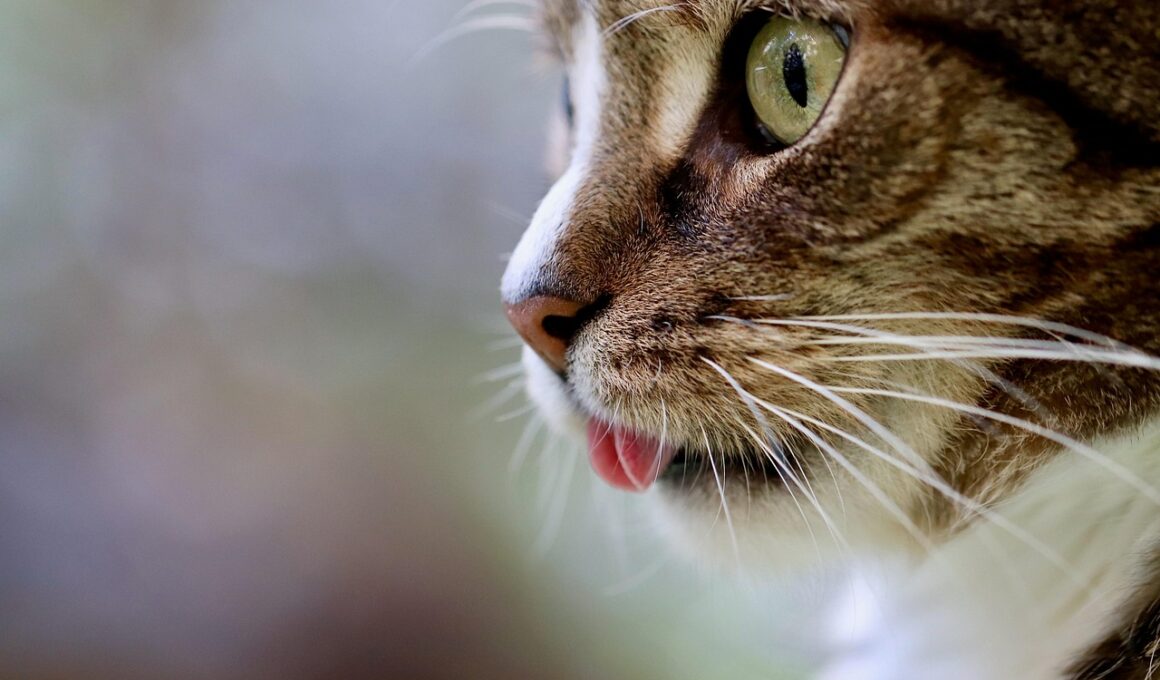Owner Communication Techniques to Improve Cat Mental Health
Understanding the psychological state of your feline friend is essential for promoting their mental well-being. A cat’s mental health can significantly improve when owners practice effective communication techniques. Each interaction shapes their perception of safety and affection. Engaging with your cat involves observing their body language, vocalizations, and overall demeanor. Educating yourself about recognized cat behaviors provides insights into their needs and feelings. Positive reinforcement through calming tones and gentle approaches fosters trust. Consistency is vital in creating a secure environment, where a cat can express themselves freely without fear. It’s crucial to learn how to interpret your cat’s unique signals; for instance, a twitching tail might indicate annoyance, while a purr typically denotes contentment. Moreover, providing ample opportunities for play and mental stimulation through toys adds further support to their emotional landscape. If your cat seems distressed or anxious, consider adopting changes in your interaction style. Patience and understanding are key elements in nurturing a profound bond with your cat, ultimately benefiting both their mental state and your overall relationship.
One fundamental communication technique involves maintaining eye contact to convey affection and respect. Cats often feel secure when they perceive their owners are attentive and engaged. Additionally, utilizing a soft, soothing voice can have a calming effect on your feline companion. Each cat responds to different sound frequencies, so singing or talking in a melodic tone can resonate positively. Offering a consistent daily routine brings stability to their lives, fostering a sense of security. Scheduled feeding times, play sessions, and cuddling can be particularly beneficial, as cats thrive on predictability. To promote socialization, consider allowing your cat to meet new people and environments gradually; this helps them adjust to changes without becoming overwhelmed. Create safe spaces for retreat, where your cat can observe and adapt at their own pace. Ensuring their living space is comfortable, with enriched environments including climbing structures and hideaways promotes mental well-being. Additionally, interactive play enhances their cognitive functions. Engaging with puzzle toys can encourage their natural hunting instincts while providing mental stimulation. Always consult with a veterinarian regarding behavioral changes to rule out underlying issues; addressing health concerns is crucial in supporting them.
Recognizing Stress Signs
Being aware of the signs of stress in your cat is vital for addressing their emotional needs. Like humans, cats can experience anxiety and stress; recognizing these signs allows for timely intervention. Common indicators of stress include excessive grooming, hiding, or changes in appetite. When your cat exhibits these behaviors, assess their environment for potential stressors. Adjustments regarding their surroundings can significantly impact their mental well-being, such as reducing loud noises or introducing calming scents like lavender. Additionally, allowing your cat time to acclimate to new situations is critical. Changes in residence or family dynamics require patience, as your feline may feel insecure amidst transition. Observe how your cat reacts to visitors; some may become more social while others might withdraw. Your approach in handling introductions could set the tone for their comfort level. Confidently navigating new experiences together strengthens the bond between you and your cat. Ensuring they feel secure enough to express their discomfort is crucial. Utilize gentle encouragement rather than forceful handling or coercion, reinforcing your role as their protector and ally. This dynamic will build trust and assist them in coping with challenging situations.
Providing a dedicated space for your cat can alleviate stress. Cats often appreciate having a sanctuary that feels safe and secure, ideally away from human foot traffic. Incorporating sensory elements such as pleasing scents, various textures, and sound can enhance their emotional comfort. Additionally, create vertical spaces in your home to encourage climbing and exploration; this caters to their natural instincts. Providing opportunities for exercise and exploration contributes to their mental health by stimulating their minds and bodies. Regular interactions engaging their senses like sight, sound, and smell contribute significantly to enhancing their living experience. Consider rotating toys to maintain their interest, as boredom can lead to stress or behavioral issues. Observing what captures your cat’s attention can inform future choices in playtime activities, thus improving their overall mental condition. Healthy interactions will lead to a more relaxed atmosphere, benefitting both pet and owner. Implement mindful practices, including playtime at least once a day, tailored to your cat’s preferences. Meeting their emotional needs is an ongoing journey requiring positive reinforcement techniques alongside understanding their cues.
Nurturing Positive Human-Cat Relationships
Building a positive relationship between you and your cat significantly impacts their mental well-being. Effective communication plays a crucial role in nurturing trust and understanding through simple practices. For example, engaging in regular even-tempered conversations helps your cat feel secure in your presence. Offer affection on their terms; some cats may prefer gentle strokes, while others might thrive on playful interactions. Developing patience is vital when coaxing your cat out of their shell; siempre allow them the freedom to approach you whenever they choose. Offering treats can further strengthen this bond by associating your presence with positivity and care. Remember that learning their unique preferences takes time. Be sure to indulge in activities they enjoy, fostering a sense of togetherness. Spend quality time cuddling or grooming to instill feelings of safety and comfort; this strengthens attachments beyond mere ownership. For anxious felines, avoid overwhelming encounters; create a bond through gradual exposure at their pace. Exploring interactive play sessions together reinforces your partnership. Always celebrate milestones associated with positive behavior while remaining attentive to their moods. Cherishing these small, intentional moments can significantly enhance their mental health.
Cats often communicate their needs through gestures, and it is essential to learn how to interpret those signals effectively. Body language, such as a slow blink, indicates trust, while an arched back could mean the opposite. Practicing two-way communication ensures that your cat feels heard and valued. Respect their boundaries; pushy interactions can lead to distrust and increased anxiety. Allowing them safe spaces without disturbances empowers them to voice their needs more freely. Establish healthy boundaries through gentle guidance that instills respect and understanding in your interactions. Pay attention to their preferences regarding physical and emotional space during play. Offering moments of solitude can reduce stress levels significantly while promoting comfort zones. A safe environment will ultimately encourage positive behaviors in your cat. When addressing behavioral challenges, consider enlisting a veterinarian or animal behaviorist to provide expertise. Professional intervention may uncover underlying health issues and tailoring solutions to your situation that strengthens your bond through thoughtful communication. By treating your relationship with care and dedication, you contribute substantially to your cat’s mental well-being, paving the way for a happier, healthier pet.
Conclusion
In conclusion, improving your cat’s mental health primarily revolves around effective communication, understanding, and responsiveness to their needs. Applying techniques that promote emotional well-being can lead to a lifespan filled with joy and security for your feline friend. Engaging in gentle, reassuring voice tones can significantly impact your cat’s perception of their environment. By recognizing stress signals, providing care through routines, and fostering security, owners can create a healthy relationship built on trust. Explore various communication techniques to form a unique bond that benefits both you and your cat. Make their happiness a priority in every interaction, as this will contribute greatly to their mental wellness. Involve the entire family in establishing a supportive environment for the cat through open conversations about their behaviors and needs. Overall, establishing a relationship based on understanding, patience, and love creates a nurturing atmosphere. It is essential to celebrate your cat’s individuality in every aspect of their life. Reinforce positive moments and validate their feelings while fostering a loving attitude in your shared time. By integrating these practices, you can enhance your cat’s mental health significantly.


